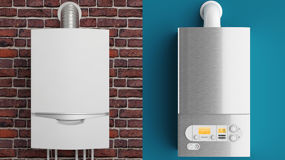This week we have decided to run you through the technical differences of the main three types of boiler that you are likely to find in your home.
These three main types of boiler are gravity boilers, combination boilers, and unvented cylinder boilers, commonly known as Megaflo boilers. Though similar in some ways, these boiler types have their differences – the main variation being the water pressure each can put out, and how they circulate hot water throughout your home.
It is important that you know your type of boiler so you can be sure of the water pressure in your home before any renovation attempts!
So, if you have been asking yourself “what kind of boiler do I have?” then buckle down and get ready to be illuminated.
Different Types of Boiler Explained
Gravity Boilers
First up in our technical guide to boilers is the gravity boiler system. With this type of boiler, the water tank is most often located in the loft of your home with the hot water cylinder located in an airing cupboard on the floor below.
When it comes to water pressure, a gravity boiler system usually provides around 0.1-0.2 bar of pressure. This is based on the calculation that every metre the water falls creates 0.1 bar of water pressure. So as most UK designs featuring gravity boiler systems see a 1-2 metre drop from loft to airing cupboard, we can expect 0.1-0.2 bar water pressure.
The gravity boiler system heats water inside to a minimum of 60°c to effectively kill all bacteria that may be brewing within the water tank. It is one of the older boiler types, which is why it is the type of boiler that you will most likely find in homes that are not modern builds.
Due to the gravity boiler’s relatively lower pressure, you can expect to focus on lower pressure taps and shower heads when selecting the best units for your gravity boiler.
Combination Boilers
Next in our boiler explanation is the combination boiler system, commonly known as a 'combi boiler.' It is the most common type of boiler when it comes to supplying medium pressure systems.
These boiler types are highly cost-effective as they heat water as and when the home’s hot water taps are activated – meaning no energy is wasted throughout the day heating water that ultimately may not be used. It should also be noted that combi boiler water pressure cannot be augmented with the use of a pump, as can be achieved with other types of boiler.
Depending on the force of the mains entering your property, you can expect 1.0-1.5 bar water pressure from a combination boiler system. As water enters your home from the mains, the combi boiler receives it then begins to heat it with gas. And as with the gravity boiler, the water is heated to at least 60°c to ensure all impurities are eradicated.
A key factor with combi boilers to remember is that, as the water comes fresh from the mains and not from storage in a loft, it is not a risk to drink water from the bathroom taps – as it may be with a gravity boiler-supplied home. But nothing is ever perfect.
One disadvantage of a combination boiler system is that, due to the set pressure of your mains water supply, the pressure of your hot water will lessen in accordance with the number of taps, showers and other outlets that you add to the system.
Unvented Cylinder Boilers or Megaflo Boilers
Last but certainly not least, we have the unvented cylinder boiler type. While this is the correct terminology, you will find these commonly referred to as Megaflo systems as this was the brand that created and popularised the technology.
This impressive boiler type consists of a hot water cylinder paired with a smaller expansion tank and has no cold-water storage. The expansion tank is required to accommodate the water as it heats and expands due to this design’s unvented nature.
The Megaflo boiler provides properties with a far higher-pressure delivery than the gravity and combination boiler types we have just covered. With figures averaging 3-5 bar water pressure, you are pretty much without restriction when it comes to selecting your ideal taps and shower systems.
The unvented nature and high pressure also mean you need not rely on shower pumps to get your showers performing at full capacity. And with direct mains supply, there is no need for a cold-water storage tank, promoting space and minimising pipework.
However, due to the sheer size of the Megaflo system, it becomes a requirement that the mains supply be of a certain magnitude. The balance between mains water pressure and length of pipe to be travelled must also be balanced. If not, the Megaflo system cannot perform as intended.
Too powerful for the average size household, you will discover unvented cylinder boilers in large new-build houses and mansions, as well as larger architectures such as public buildings.
And where will you find the Megaflo? Often, it will the boiler and its accompanying unvented cylinders will be located in a peripheral location such as a garage, or even an outhouse made specifically to hold its powerful structure.
Which Boiler Type Do I Have?
So, we have now covered the three main types of boiler that you are likely to encounter. Were you able to work out which you had, or do you require a little more help?
Never fear, our convenient Only Radiators Boiler Identifier is here to save the day!
Do you have an airing cupboard?
If you have an airing cupboard – that’s the closet upstairs where you hang clothes to dry quickly – featuring a huge cylinder then you most likely have a gravity system or unvented cylinder. If your house is not what you would call a mansion, you can bet it is a gravity boiler system.
It is true that you will occasionally find a combi boiler in an airing cupboard, though it is highly unlikely as water is jettisoned in on demand from the mains and there is no need for a tank.
Do you have a tank in the loft?
Most gravity boiler systems will feature a large tank in the loft. This is where all the water is kept and the gravity boiler’s water heating process starts.
As we mentioned, combi boilers need no tank. And while unvented cylinders may occasionally feature in a property’s loft, they are more likely to be situated at ground level. So, we can say with fair certainty that a tank in the loft suggests a gravity boiler system.
Do you have a boiler in the kitchen?
If your kitchen is where you find your boiler, your home may well be heated by a combi boiler system – though a gravity system can sometimes feature a kitchen-based boiler, too.
You can at least count out unvented pressure systems. The sheer size of Megaflo boiler designs prevents them from featuring in the kitchen for reasons of safety.
When you turn the hot water on, does the boiler turn on?
Gravity boilers turn on when you tell them – not when you run the hot water. Combination boilers turn on when you turn the hot water on, and you will hear the gas alighting.
Unvented cylinder boilers, meanwhile, are always on and refill when needed. So, this is one of the surest factors when it comes to answering, “what type of boiler do I have?”
Do you have a boiler with a large tank next to it and/or smaller tank above it?
Unvented cylinders are unique in this design. You will find the boiler situated with an unvented cylinder next to it, and a smaller expansion tank located above the unvented cylinder. Both gravity and combination boiler systems do not feature this set up.
What it Boils Down To
And just like that, we have cracked the case. With your potential types of boiler explained, you can now define the home heating system you have and conduct your home maintenance more effectively!
Here to Help
Our friendly customer service and sales teams are always here to help. So if you have any lingering questions on your boiler type or would simply like to discuss anything in the world of home radiators, feel free to reach out to us.
We are always delighted to share our collective decades of home heating experience with you – and we look forward to chatting!








